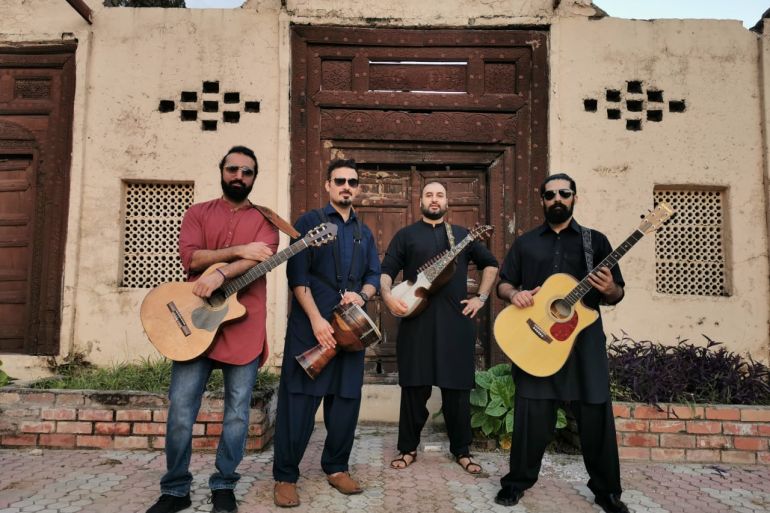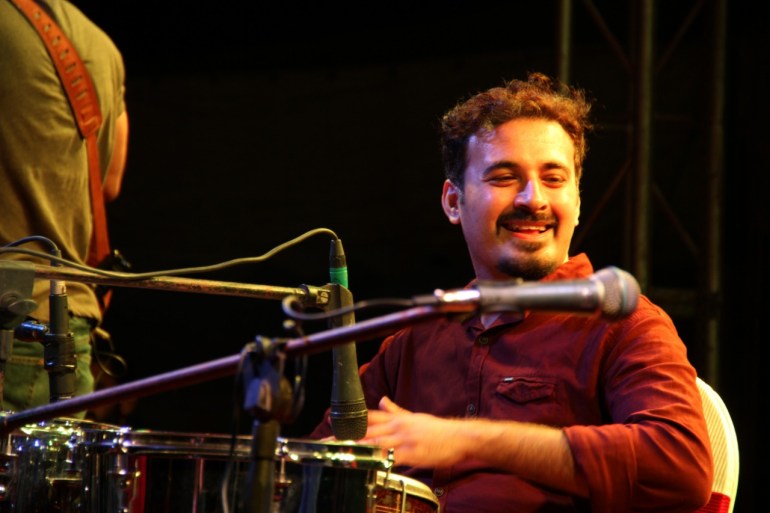How a Pakistani folk band changed Pashtun narrative through music
Khumariyaan’s distinctive sound reinvigorates a rich and varied music genre, with special focus on an instrument called rubab.

When Farhan Bogra was teaching himself how to play the rubab, an ancient instrument played by ethnic Pashtuns, 15 years ago in Peshawar, little did he know that his native Khyber Pakhtunkhwa province was on the brink of war that lasted more than a decade.
The Tehreek-e-Taliban Pakistan (TTP, also known as the Pakistan Taliban) formed a year later, killing thousands of Pakistanis across the country with indiscriminate bombings and shootings. The Taliban – many of them ethnic Pashtuns – banned musical performances and imposed a conservative form of Islam in the areas they held influence over.
Keep reading
list of 3 itemsWhy is Pakistan’s Pashtun movement under attack?
Pashtuns’ struggle for rights cannot be silenced through violence
As depictions of Pashtuns in Western and Pakistani popular culture focused on extremism and violence, Pashtuns – who form roughly 20 percent of Pakistan’s 207 million people – came to be associated with the violence, rather than as victims of the Taliban’s rise.
“A good image was not portrayed of [Pashtun] music instruments,” said Bogra, speaking to Al Jazeera about the class taboo around performing music in Pashtun culture. “People didn’t let their children play the rubab. Even I faced a lot of resistance from my family.”
As the military drove the TTP from its strongholds in the northwest from 2014 onwards, violence has receded dramatically in the last three years. But rights groups such as the Pashtun Tahaffuz Movement (PTM) say widespread discrimination against Pashtuns, particularly by Pakistani security forces, continues unabated.
Amid all this, Pakistani folk music band Khumariyaan, of which Bogra is a part, are changing the narrative around their ethnic group through music.

Bogra and his fellow Pashtuns Sparlay Rawail, Shiraz Khan, and Aamer Shafiq, all from Khyber Pakhtunkhwa, first beguiled Pakistanis in 2009 with their distinct combination of the sweet, fluttering sound of the rubab – a stringed instrument popular in Afghanistan, Pakistan and Iran – masterfully combined with guitar melodies and percussion.
Since then, Khumariyaan’s distinctive sound has reinvigorated a rich and varied music genre epitomised by the Queen of Pashtun tappay (folk songs), Zarsanga; the poetic ghazals of Afghan vocalist Nashenas; Pakistan’s Sardar Ali Takkar, who sang for Malala Yousufzai at the Nobel Peace Prize ceremony in 2014; and the pop music of artists such as Gul Panra and Rahim Shah.
The band was eager to reach a generation of young Pashtun graduates from their native Peshawar who were hungry for new, modern music that spoke to their cultural heritage.
“We felt that Pashto folk music, in general, had become a bit stagnant,” says guitarist Sparlay Rawail. “If it wasn’t Sardar Ali Takkar or Nashenas and you listened to Pashto music, it meant that you belonged to [the lower] class.”
Bogra, who also works to preserve the traditions of Pakistani artisans and musicians, rapidly saw the rubab, an irreplaceable cornerstone of Pashtun culture, vanishing before his eyes.
“I remember giving a rubab to a friend [in 2006]. But his father broke it, gave him a guitar instead and said that the rubab is the sound of the lower-class, of [rickshaw] drivers,” he recalls.

Today, Khumariyaan are among a new creative generation of young Pashtun musicians resurrecting reverence for Pashto folk music in the Pakistani national consciousness.
In 2018, their cover of the classic Pashtun folk song Ya Qurban on live music series Coke Studio Pakistan (sponsored by the multinational beverage company) catapulted the band onto the global stage, as the video amassed more than 13 million views on YouTube.
Rawail said this movement to revive Pashtun music has sparked not just a newfound love for the rubab’s resonant sound, but also a desire to play the instrument.
“In 2000, the production of the rubab [in Pakistan] had gone completely down,” Rawail said. “People weren’t listening to it. Now, everyone wants to buy a rubab […].”
Even as neo-Pashto folk music like Khumariyaan’s marches towards modernity, Karan Khan, one of Pakistan’s most prominent Pashtun folk singers, says the richness of the Pashto language and the transcendent power of the rubab combined with contemporary instruments have drawn audiences young and old to its unique sound.
“When [musicians] sing our folk compositions with new instruments, they are modernized, but they remain folk in their taste and colour, that’s why those [songs] attract people,” says Khan. “Those old compositions and lyrics were powerful enough to introduce these modern instruments to audiences.”
Khan was forced to flee Pakistan’s northern Swat valley in 2008 with his family, with more than two million others who became internally displaced after the province became a battleground for the Pakistani army’s offensive against the Taliban. His music career materialised from struggle and displacement at a time when performing music was stigmatised.
But for a new generation of Pashtun musicians emerging from the northwestern provinces that were once eclipsed by violence, Khan says that is slowly changing.
“Look at the families to which these boys belong, then look at the villages where their families are located,” he said.
“Ten, fifteen years ago, people did not consider music as a respectable profession. Now, boys in universities are [increasingly] interested in music.”
“Rubab is an instrument is beautiful in fusion,” he said. “It feels good as a standalone instrument, in Sufism, parties, attan, it looks good in jazz, rock, pop, hip-hop, it feels good in all these forms of music.

A brief history of rubab
Though different variations of the rubab exist in Pakistan, Iran and Uzbekistan, its roots can be traced back to Afghanistan, where it is the national instrument.
“The rubab that Khumariyaan plays dates to the medieval period as a uniquely Afghan instrument, though possible ancestors can be seen in 4th-century Buddhist sculptures in the Afghan-Pakistan borderlands,” says historian of Pashto literature and culture, Dr James Caron at the University of London’s School of Oriental and African Studies.
The rubab was especially revered by the 16th century Roshaniyya Sufi movement, led by Pashtun warrior-poet Bayazid Pir Roshan, who is also said to have created the first Pashtun alphabet.
“In the 16th century, among the earliest Pashto texts describe the rubab’s use in Sufi rituals that were intended to open a conduit between one’s embodied senses and higher spirit realms,” Dr Caron said.
The instrument has evolved over the centuries, with the Afghan and Pakistani rubabs of today being quite different to the instrument’s 10th-century form, according to ethnomusicologist Professor John Baily at the Afghan Music Unit of London’s Goldsmiths University.
“There are accounts of mounted troops of [Pashtuns] being led into battle on horseback, singing patriotic, nationalistic Pashtun songs and playing the rubab,” Baily said.
The dance to that music, known as the attan, has in modern times become a traditional part of Pashtun weddings, celebrations and folk music performances around the world.
Fighting anti-Pashtun sentiment with music
The rise of the Taliban and the so-called “war on terror” devastated music production in the region. As the TTP gained influence over more and more territory, including Peshawar, Pakistan’s streets, which once reverberated with all forms of music – qawwali, folk and contemporary – fell silent as music was banned in many places, instrument makers were shut down and musicians were killed or threatened.
The threats caused an exodus of Pashtun musicians, including prominent figures like Sardar Ali Takkar and Haroon Bacha, who sought asylum abroad.
The military’s anti-Taliban operations have brought their own allegations of anti-Pashtun discrimination, with the PTM documenting thousands of cases of forced disappearances allegedly carried out by the military.
The military did succeed in breaking the Taliban’s hold over most of the province, and with it the ban on music that prevailed for years. From South Waziristan to Khyber, public performances have slowly begun to return to the streets of former Taliban strongholds.
“Our music is aimed at anyone who has preconceived notions about Pashtuns,” says Rawail.
“If the narrative is that Pashtuns are backward, they’re not well educated, they don’t know how to be ‘civilised’, and they don’t know how to create art and be creative, then certainly we are breaking stereotypes.”
The band has taken it upon themselves to carry that torch. In the days following the massacre of 148 people, most of them children, at a Peshawar school in 2014, Khumariyaan held a public concert for a city that was drowning in grief.
Propelled by the desire to build a musical bridge between Pashtuns and other groups, and to kickstart their own cultural revolution, the band is trying to bring people together – not just in Pakistan, but around the world.
“Everybody else is celebrating their rich musical culture,” Rawail added, “and it’s about time we do as well.”